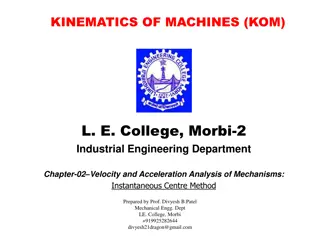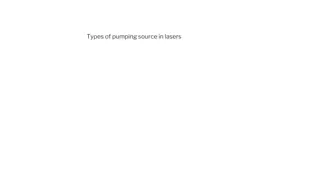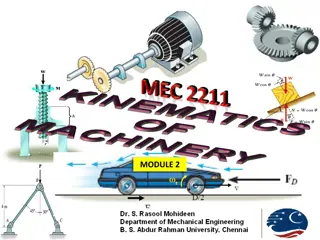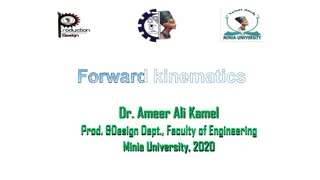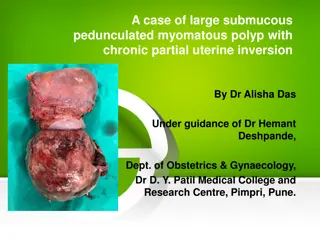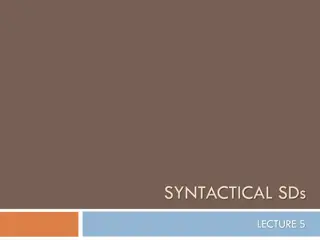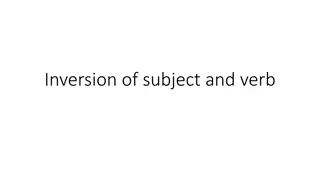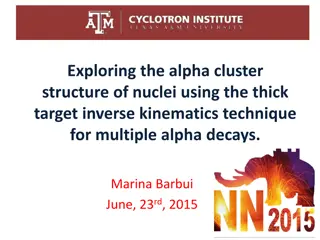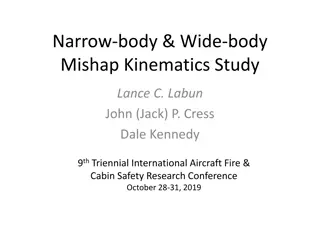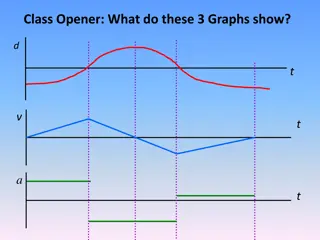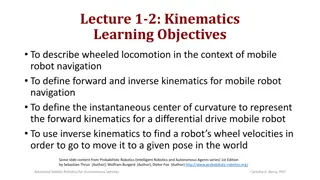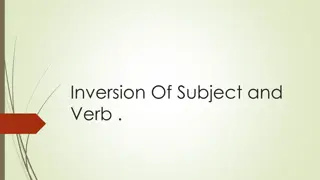Understanding the Inversion of Mechanisms in Kinematics
Inversion of Mechanisms in Kinematics involves measuring absolute and relative motions in stationary and moving frames, respectively. By fixing different links in a kinematic chain, we can obtain various mechanisms. This process does not alter relative motions but may significantly change absolute motions. The roles of driver and follower in mechanisms are explained, and important kinematic chains with lower pairs are discussed, including the four-bar chain.
Download Presentation

Please find below an Image/Link to download the presentation.
The content on the website is provided AS IS for your information and personal use only. It may not be sold, licensed, or shared on other websites without obtaining consent from the author. Download presentation by click this link. If you encounter any issues during the download, it is possible that the publisher has removed the file from their server.
E N D
Presentation Transcript
1.16. Inversion of Mechanism Absolute motion is measured with respect to a stationary frame. Relative motion is measured for one point or link with respect to another link. We have already stated that when one of links is fixed in a kinematic chain, it is called a mechanism. So we can obtain as many mechanisms as the number of links in a kinematic chain by fixing, in turn, different links in a kinematic chain. This method of obtaining different mechanisms by fixing different links in a kinematic chain, is known as inversion of the mechanism.
1.16. Inversion of Mechanism It may be noted that the relative motions between the various links is not changed in any manner through the process of inversion, but their absolute motions (those measured with respect to the fixed link) may be changed drastically.
1.16. Inversion of Mechanism Note: The part of a mechanism which initially moves with respect to the frame or fixed link is called driver and that part of the mechanism to which motion is transmitted is called follower. Most of the mechanisms are reversible, so that same link can play the role of a driver and follower at different times. For example, in a reciprocating steam engine, the piston is the driver and flywheel is a follower while in a reciprocating air compressor, the flywheel is a driver.
1.16. Inversion of Mechanism The most important kinematic chains are those which consist of four lower pairs, each pair being a sliding pair or a turning pair. The following three types of kinematic chains with four lower pairs are important from the subject point of view : 1. Four bar chain or quadric cyclic chain, 2. Single slider crank chain, 3. Double slider crank chain. These kinematic chains are discussed, in detail, in the following articles.
1.16. Inversion of Mechanism 1.Four Bar Chain or Quadric Cycle Chain We have already discussed that the kinematic chain is a combination of four or more kinematic pairs, such that the relative motion between the links or elements is completely constrained. The simplest and the basic kinematic chain is a four- bar chain or quadric cycle chain, as shown in Fig. 1. 32. https://youtu.be/KBFFwgCCP0U https://youtu.be/0neC37jBxQw https://youtu.be/uvJjFgRqSTg Fig. 1.32 Four bar chain It consists of four links, each of them forms a turning pair at A, B, C and D. The four links may be of different lengths.
1.16. Inversion of Mechanism In a four bar chain, one of the links, in particular the shortest link, will make a complete revolution relative to the other three links, if it satisfies the Grashof s law. Such a link is known as crank or driver. In Fig. 1.32, AD (link 4 ) is a crank. The link BC (link 2) which makes a partial rotation or oscillates is known as lever or rocker or follower and the link CD (link 3) which connects the crank and lever is called connecting rod or coupler. The fixed link AB (link 1) is known as frame of the mechanism. When the crank (link 4) is the driver, the mechanism is transforming rotary motion into oscillating motion.
1.16. Inversion of Mechanism A very important consideration in designing a mechanism is to ensure that the input crank makes a complete revolution relative to the other links. The mechanism in which no link makes a complete revolution will not be useful in such applications. For the four-bar linkage there is a very simple test of whether this is the case. Grashof s law for four-bar mechanism. If one of the links can perform a full rotation relative to another link, the linkage is called a Grashof mechanism. Grashof s law states that for a planar four-bar mechanism (linkage), the sum of the shortest and longest link lengths can not be greather than the sum of the other two link lengths if there is to be continuous relative motion between two members.
1.16. Inversion of Mechanism This is illustrated in Fig. 1.33, where the longest link has length l, the shortest link has length s , and the other two links have lengths p and q. Grashof s law states that one of the links , in particular the shortest link, will rotate continuously relative to the other three links if only if or + + L L L L max min a b where Lmax and Lmin are the longest and shortest links, La and Lb are each links of intermediate length. If this nequal ty is not satisfied no link will make a complete revolution relative to another.
1.16. Inversion of Mechanism Fig. 1.33. Four inversions of the Grashof chain c) a) b) d) < https://youtu.be/mwPIB89V-L8 https://youtu.be/9D0IBiM4_1M https://youtu.be/Tjr2c4d09wQ https://youtu.be/eojqAbhdg_w
1.16. Inversion of Mechanism It should be notted that nothing in Grashof s law specifies the order in which the links are connected or which link of the four bar chain is fixed. Hence, by fixing any of the four links, we create four inversions of the four bar mechanism shown in Fig.1.33. The drag-link mechanism is obtained by fixing the shortest link s as the frame, as shown in Fig. 1.33a. In this inversion, both links adjacent to s can rotate continously, and both are properly described as cranks: the shortest of the two is generally used as the input If the shortest links is adjacent to the fixed link, as shown in Figs.1.33b, a crank-rocker mechanismis obtained. Link s, the crank, since it is able to rotate continously , and link p, which can only oscilate between limits, is the rocker.
1.16. Inversion of Mechanism By fixing the link opposite to s we obtain the the third inversion, the double-rocker mechanism of Fig. 1.33c. Note that although link s is able to make a complete revolution , neither link adjacent to the frame can do so; both must oscilate between limits and are therefore rockers. If i.e. or s=p and l=q then, the forth inversion, the parallelogram or change-point or crossover- position mechanism is optained as shown in Fig.1.33d. In each of these inversions , the shortest link s is adjacent to the longest link l . However, exactly the same types of linkages inversions will occur if the longest link l is opposite the shortest links. + + L L Lp Lq max min
1.16. Inversion of Mechanism AI-Inversions of Four Bar Chain Though there are many inversions of the four bar chain, yet the following are important from the subject point of view : 1. Beam engine (crank and lever(rocker) mechanism). 2. Coupling rod of a locomotive (Double crank mechanism). 3. Watt s indicator mechanism (Double lever(rocker) mechanism).
1.16. Inversion of Mechanism 1. Beam engine (crank and lever (rocker) mechanism https://youtu.be/1e8ZWsOzun4 A part of the mechanism of a beam engine (also known as crank and lever mechanism) which consists of four links, is shown in Figs. 1.34 and 1.35 . https://youtu.be/bmh0a2Ol0u8 https://youtu.be/bmh0a2Ol0u8 Fig. 1.34 Beam engine Fig.1.35 Beam engine mechanism In this mechanism, when the crank rotates about the fixed centre A, the lever oscillates about a fixed centre D. The end E of the lever CDE is connected to a piston rod which reciprocates due to the rotation of the crank. In other words, the purpose of this mechanism is to convert rotary motion into reciprocating motion.
1.16. Inversion of Mechanism 2. Coupling rod of a locomotive (Double crank mechanism). The mechanism of a coupling rod of a locomotive (also known as double crank mechanism) which consists of four links, is shown in Fig. 1.36. https://youtu.be/gYmT1M4NyyM Fig. 1.36. Coupling rod of a locomotive In this mechanism, the links AD and BC (having equal length) act as cranks and are connected to the respective wheels. The link CD acts as a coupling rod and the link AB is fixed in order to maintain a constant centre to centre distance between them. This mechanism is used for transmitting rotary motion from one wheel to the other wheel.
1.16. Inversion of Mechanism 3. Watt s indicator (Double rocker) mechanism. A Watt s indicator mechanism (also known as Watt's straight line mechanism or double lever mechanism) which consists of four links, is shown in Fig. 1.37. Fig.1.37. Watt s indicator mechanism The four links are : fixed link at A, link AC, link CE and link BFD. It may be noted that BF and FD form one link because these two parts have no relative motion between them. The links CE and BFD act as levers. The displacement of the link BFD is directly proportional to the pressure of gas or steam which acts on the indicator plunger. On any small displacement of the mechanism, the tracing point E at the end of the link CE traces out approximately a straight line. The initial position of the mechanism is shown in Fig. 1.37 by full lines whereas the dotted lines show the position of the mechanism when the gas or steam pressure acts on the indicator plunger.
1.16. Inversion of Mechanism B. Single Slider Crank Chain A single slider crank chain is a modification of the basic four bar chain. It consist of one sliding pair and three turning pairs. It is, usually, found in reciprocating steam engine mechanism. This type of mechanism converts rotary motion into reciprocating motion and vice versa. Fig. 1.38. Single slider crank chain
1.16. Inversion of Mechanism In a single slider crank chain, as shown in Fig. 1.38, the links 1 and 2, links 2 and 3, and links 3 and 4 form three turning pairs while the links 4 and 1 form a sliding pair. The link 1 corresponds to the frame of the engine, which is fixed. The link 2 corresponds to the crank ; link 3 corresponds to the connecting rod and link 4 corresponds to cross-head. As the crank rotates, the cross-head reciprocates in the guides and thus the piston reciprocates in the cylinder.
1.16. Inversion of Mechanism BI: Inversions of Single Slider Crank Chain We have seen in the previous article that a single slider crank chain is a four-link mechanism. We know that by fixing, in turn, different links in a kinematic chain, an inversion is obtained and we can obtain as many mechanisms as the links in a kinematic chain. It is thus obvious, that four inversions of a single slider crank chain are possible. These inversions are found in the following mechanisms.
1.16. Inversion of Mechanism 1. Pendulum pump or Bull engine. In this mechanism, the inversion is obtained by fixing the cylinder or link 4 (i.e. sliding pair), as shown in Fig. 1.39. In this case, when the crank (link 2) rotates, the connecting rod (link 3) oscillates about a pin pivoted to the fixed link 4 at A and the piston attached to the piston rod (link 1) reciprocates. The duplex pump which is used to supply feed water to boilers have two pistons attached to link 1, as shown in Fig. 1.39.
1.16. Inversion of Mechanism Fig. 1.39 Pendulum pump https://youtu.be/mxgPTsXpB6k
1.16. Inversion of Mechanism 2. Oscillating cylinder engine. The arrangement of oscillating cylinder engine mechanism, as shown in Fig. 1.40, is used to convert reciprocating motion into rotary motion. In this mechanism, the link 3 forming the turning pair is fixed. The link 3 corresponds to the connecting rod of a reciprocating steam engine mechanism. When the crank (link 2) rotates, the piston attached to piston rod (link 1) reciprocates and the cylinder (link 4) oscillates about a pin pivoted to the fixed link at A. https://youtu.be/cz4tCwwvvDM Fig.1.40 Oscilating cylinder engine
1.16. Inversion of Mechanism 3. Rotary internal combustion engine or Gnome engine. Sometimes back, rotary internal combustion engines were used in aviation. But presently gas turbines are used in its place. It consists of seven cylinders in one plane and all revolves about fixed centre D, as shown in Fig. 1.41, while the crank (link 2) is fixed. In this mechanism, when the connecting rod (link 4) rotates, the piston (link 3) reciprocates inside the cylinders forming link 1.
1.16. Inversion of Mechanism http://www.century-of-flight.net/Aviation%20history/airplane%20at%20war/upload2/new%20images/4.gif Fig. 1.41 https://youtu.be/W3elogQimk4 https://youtu.be/0jHRuEkvO8E
1.16. Inversion of Mechanism 4. Crank and slotted lever quick return motion mechanism. This mechanism is mostly used in shaping machines, slotting machines and in rotary internal combustion engines. Fig.1.42 https://youtu.be/ESBYdJx8X7k https://youtu.be/s3TiMedJKds
1.16. Inversion of Mechanism In this mechanism, the link AC (i.e. link 3) forming the turning pair is fixed, as shown in Fig. 1.42. The link 3 corresponds to the connecting rod of a reciprocating steam engine. The driving crank CB revolves with uniform angular speed about the fixed centre C. A sliding block attached to the crank pin at B slides along the slotted bar AP and thus causes AP to oscillate about the pivoted point A. A short link PR transmits the motion from AP to the ram which carries the tool and reciprocates along the line of stroke R1R2. The line of stroke of the ram (i.e. R1R2) is perpendicular to AC produced.
1.16. Inversion of Mechanism Whitworth quick return motion mechanism 5. Whitworth quick return motion mechanism. Fig. 1.43 https://youtu.be/UuTNtg7-Bwg
1.16. Inversion of Mechanism This mechanism is mostly used in shaping and slotting machines. In this mechanism, the link CD (link 2) forming the turning pair is fixed, as shown in Fig. 1.43. The link 2 corresponds to a crank in a reciprocating steam engine. The driving crank CA (link 3) rotates at a uniform angular speed. The slider (link 4) attached to the crank pin at A slides along the slotted bar PA (link 1) which oscillates at a pivoted point D. The connecting rod PR carries the ram at R to which a cutting tool is fixed. The motion of the tool is constrained along the line RD produced, i.e. along a line passing through D and perpendicular to CD.
1.16. Inversion of Mechanism When the driving crank CA moves from the position CA1 to CA2 (or the link DP from the position DP1 to DP2) through an angle in the clockwise direction, the tool moves from the left hand end of its stroke to the right hand end through a distance 2 PD. Now when the driving crank moves from the position CA2 to CA1 (or the link DP from DP2 to DP1 ) through an angle in the clockwise direction, the tool moves back from right hand end of its stroke to the left hand end. A little consideration will show that the time taken during the left to right movement of the ram (i.e. during forward or cutting stroke) will be equal to the time taken by the driving crank to move from CA1 to CA2. Similarly, the time taken during the right to left movement of the ram (or during the idle or return stroke) will be equal to the time taken by the driving crank to move from CA2 to CA1.
1.16. Inversion of Mechanism Since the crank link CA rotates at uniform angular velocity therefore time taken during the cutting stroke (or forward stroke) is more than the time taken during the return stroke. In other words, the mean speed of the ram during cutting stroke is less than the mean speed during the return stroke. The ratio between the time taken during the cutting and return strokes is given by Time of cutting stroke/ Time of return stroke = / = /( 360 - ) or = (360 )/ Note. In order to find the length of effective stroke R1 R2, mark P1 R1 = P2 R2 = PR. The length of effective stroke is also equal to 2 PD.
1.16. Inversion of Mechanism C-Double Slider Crank Chain A kinematic chain which consists of two turning pairs and two sliding pairs is known as double slider crank chain, as shown in Fig. 1.44. We see that the link 2 and link 1 form one turning pair and link 2 and link 3 form the second turning pair. The link 3 and link 4 form one sliding pair and link 1 and link 4 form the second sliding pair. https://youtu.be/iMYiM8I__vE
1.16. Inversion of Mechanism C.Inversions of Double Slider Crank Chain The following three inversions of a double slider crank chain Are important from the subject point of view: 1. Elliptical trammels. It is an instrument used for drawing ellipses. This inversion is obtained by fixing the slotted plate (link 4), as shown in Fig. 1.44. The fixed plate or link 4 has two straight grooves cut in it, at right angles to each other. The link 1 and link 3, are known as sliders and form sliding pairs with link 4. The link AB (link 2) is a bar which forms turning pairs with links 1 and 3. https://youtu.be/dilOGtjHvCE
1.16. Inversion of Mechanism Fig.1.44 Eliptical trammels
1.16. Inversion of Mechanism When the links 1 and 3 slide along their respective grooves, any point on the link 2 such as P traces out an ellipse on the surface of link 4, as shown in Fig. 1.44 (a). A little consideration will show that AP and BP are the semi-major axis and semi-minor axis of the ellipse respectively.
1.16. Inversion of Mechanism 2. Scotch yoke mechanism. https://youtu.be/hsaoTo1vuY4 8RyP214 This mechanism is used for converting rotary motion into a reciprocating motion. The inversion is obtained by fixing either the link 1 or link 3. In Fig. 1.45, link 1 is fixed. In this mechanism, when the link 2 (which corresponds to crank) rotates about B as centre, the link 4 (which corresponds to a frame) reciprocates. The fixed link 1 guides the frame. https://youtu.be/HhX-
1.16. Inversion of Mechanism Fig 1.45 Scotch yoke mechanism.
1.16. Inversion of Mechanism 3. Oldham s coupling. https://youtu.be/XvaDAbdZCyU An Oldham's coupling is used for connecting two parallel shafts whose axes are at a small distance apart. The shafts are coupled in such a way that if one shaft rotates, the other shaft also rotates at the same speed. This inversion is obtained by fixing the link 2, as shown in Fig. 1.46 (a). The shafts to be connected have two flanges (link 1 and link 3) rigidly fastened at their ends by forging. The link 1 and link 3 form turning pairs with link 2. These flanges have diametrical slots cut in their inner faces, as shown in Fig. 1.46 (b). The intermediate piece (link 4) which is a circular disc, have two tongues (i.e. diametrical projections) T1 and T2 on each face at right angles to each other, as shown in Fig. 1.46 (c). The tongues on the link 4 closely fit into the slots in the two flanges (link 1 and link 3). The link 4 can slide or reciprocate in the slots in the flanges.
1.16. Inversion of Mechanism Fig. 1.46 Oldham s coupling.
1.16. Inversion of Mechanism When the driving shaft A is rotated, the flange C (link 1) causes the intermediate piece (link 4) to rotate at the same angle through which the flange has rotated, and it further rotates the flange D (link 3) at the same angle and thus the shaft B rotates. Hence links 1, 3 and 4 have the same angular velocity at every instant. A little consideration will show, that there is a sliding motion between the link 4 and each of the other links 1 and 3.
1.16. Inversion of Mechanism If the distance between the axes of the shafts is constant, the centre of intermediate piece will describe a circle of radius equal to the distance between the axes of the two shafts. Therefore, the maximum sliding speed of each tongue along its slot is equal to the peripheral velocity of the centre of the disc along its circular path. Let = Angular velocity of each shaft in rad/s, and r = Distance between the axes of the shafts in metres. Maximum sliding speed of each tongue (in m/s), v = .r
1.16. Inversion of Mechanism Non Grashof mechanisms Four bar linkages that do not satisfy the Grashof criterion are called double rocker mechanisms of the second kind or triple- rocker mechanisms. If Lmax + Lmin>Lp +Lq no link can rotate through 360o. A computer program based on the flowchart of Figure 1.47 may be used to classify four-bar linkages by characteristics of their motion.
1.16. Inversion of Mechanism FIGURE 1. 47 Flowchat for classifying four-bar linkages accord ing to the characteristics of theirmotion.
HOMEWORK PROBLEM 1 The Grashof Criterion This problem concerns the classification of four-bar linkages. Link lengths: L0, fixed link; L1, driver crank; L2, coupler; L3, follower crank; L1= 100 mm, L2= 200 mm, L3= 300 mm. Find the ranges of values for L0, if the linkage can be classified as follows: a. Grashof mechanism b. Crank-rocker mechanism c. Drag link mechanism d. Double-rocker mechanism e. Change point mechanism f. Triple-rocker mechanism
1.17. Mechanical Advantage Mechanical advantage. Mechanical advantage of a linkage is the ratio of output torque exerted by the driven link to the necessary input torque required at the driver. The mechanical advantage of the four-bar linkage shown inFig. 1. 48 is directly proportional to the sine of the angle between the coupler and the follower and inversly proportional to the sine of the angle between the coupler and the driver. When the sign of the angle becomes zero , the mechanical advantage becomes infinite; thus, at such a position , only a small imput torque is necessary to overcome a large output torque load. This is the case when the driver AB of Fig. 1.48 is directly in line with the coupler BC; it occurs when the crank is in position AB1 and again when the crank is in position AB4. Note that these also difine extreme positions of travel of the rocker DC1 and DC4.When the four-bar linkage is in either of these positions, mechanical advantage is infinite and the linkage is said to be in a toggle position.
1.17. Mechanical Advantage Fig.1.48 Toggle positions
1.17. Mechanical Advantage Transmission angle : The angle between the coupler and the follower is called transmission angle. As this angle becomes small, the mechanical advantage decreases and even a small amount of friction will cause the mechanism to lock or jam. A common rule of thumb is that a four- bar linkage should not be used in the rigion where the transmission angle is less than 40o or 45o and no great than 135o or 140o is usually satisfactory. The extreme values of the transmission angle occur when the crank AB lies along the line of the frame AD. In Fig.1.47 the transmission angle is minimum when the crank is position AB2 and maximum when the crank has position AB3.
1.17. Mechanical Advantage Consider the four-bar linkage whose links form a quadrilateral, as in Figure 1.49. For crank angle 2 + = L L L Ld Using the law of cosines for the triangle formed by the diagonal and links 2 and 3 2 2 0 2 1 cos L 0 1 1 = + 2 2 2 2 3 2 cos Ld L L L L 2 3 FIGURE 1.49 Determination of transmission angle.
HOMEWORK PROBLEM 2 Given the driver crank length L1= 100mm, coupler length L2= 200 mm, and follower length L3= 300 mm, and considering the transmission angle, find the range of values for the fixed link L0if the linkage is to be a crank rocker. Make the design decision to limit the transmission angle to 45 135 .
1.18. Actuators and Drivers In order to operate a mechanism, an actuator, or driver device, is required to provide the input motion and energy. To precisely operate a mechanism, one driver is required for each degree of freedom exhibited. Many different actuators are used in industrial and commercial machines and mechanisms. Some of the more common ones are given in the following section.
1.18. Actuators and Drivers Electric motors (DC) produce continuous rotary motion. The speed and direction of the motion can be readily altered, but they require power from a generator or a battery. DC motors can achieve extremely high speeds up to 30,000 rpm. These motors are most often used in vehicles, cordless devices, or in applications where multiple speeds and directional control are required.
1.18. Actuators and Drivers Engines also generate continuous rotary motion. The speed of an engine can be throttled within a range of approximately 1000 to 8000 rpm. They are a popular and highly portable driver for high-power applications. Because they rely on the combustion of fuel, engines are used to drive machines that operate outdoors.




